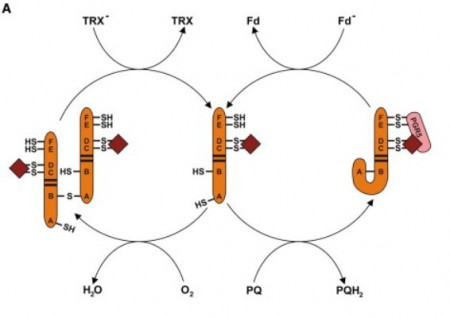Jan
7
Connecting Photosynthesis to Electricity
January 7, 2013 | 2 Comments
A team at Ludwig-Maximilians-Universität (LMU) in Munich has now found the particular enzyme that is involved in regulating electron transport during photosynthesis. Researchers have been trying to identify the missing link, which turns out to be a protein they call PGRL1, for almost 30 years.
LMU biologist Professor Dario Leister together with other members of his group has now succeeded in identifying the crucial missing link in the process. The paper has been published in Molecular Cell.
Photosynthesis is powered by sunlight, which is captured by “biochemical solar cells” called photosystems that are found in plants, algae and certain types of bacteria. Photosynthesis converts solar energy ton life sustaining fuels and the molecular oxygen for reactions that higher organisms depend on to release energy.
Plants have two photosystems, PSI and PSII. Each consists of a pigment-protein complex that uses solar energy to power electrons to a higher energy level. These are then passed along a chain of electron acceptors, and the energy released is employed for synthesis of the Adenosine TriPhosphate or ATP used for all energy transactions in cells.
Electron transport can proceed along several different routes. So-called linear electron transport requires the participation of both PSI and PSII, and delivers the electrons to a small molecule called NADP, forming NADPH. Cyclic electron flow on the other hand – which can take two alternative paths – involves only PSI, and is used solely for the production of ATP. Electrons that follow the major route are passed via an acceptor called plastoquinone to the cytochrome b6f complex and from there back to PSI, thus completing the cycle.
Professor Dario Leister said, “The identity of the carrier that donates electrons to plastoquinone, and thus makes the process of cyclic electron flow possible, has long been a subject of controversy.”
Plants can switch between linear and cyclic modes of electron transport in order to maintain the appropriate balance between ATP and NADPH, both of which are required for synthesis of sugars from CO2. This implies that the allocation of electrons between the photosystems can be regulated. An electron transporter called ferredoxin, which receives electrons directly from PSI, acts as the junction that connects the two.
Professor Leister explains, “It was therefore proposed, more than 30 years ago, that a so-called ferredoxin-plastoquinone reductase (FQR) must exist, which ensures that electrons can be re-injected into the electron transport chain, and thus allows for cyclic electron transport, but despite intensive searches, no such enzyme had been found.”
Back in 2008, Leister’s team identified the protein PGRL1, and showed that it was able to interact with PSI and with other factors known to participate in cyclic electron transport. In their latest study, they have been able to characterize the precise biochemical function of PGRL1.
Now the team can announce that the protein is the long-sought FQR that plays a central role in the regulation of cyclic electron flow. “In the long term, this finding may help us to improve photosynthetic performance by replacing or modifying specific components of the electron transport chain,” Leister points out.
This opens up a lot of new perspective on plant biology in foods and fuels. Pivotal regulators such as PGRL1 could possibly be tuned in a targeted fashion so as to enhance the efficiency of photosynthesis and thus increase yields in crop plants grown under controlled conditions.
Beyond that a complete understanding of the structure and regulation of the photosystems is a prerequisite for the development of methods that would allow scientists to optimize the process of photosynthesis for various applications such as raising crop yields, designing new types of solar cells or generating molecular hydrogen for use as an environmentally friendly energy source.
Its pretty deep basic plant biology, but one more bewilderment about what’s happening in there, bites the dust.
Comments
2 Comments so far



Article writing is also a excitement, if you be familiar
with after that you can write if not it is difficult to write.
Thanks for the good writeup. It in truth was a entertainment
account it. Look complex to far delivered agreeable
from you! However, how could we keep up a correspondence?